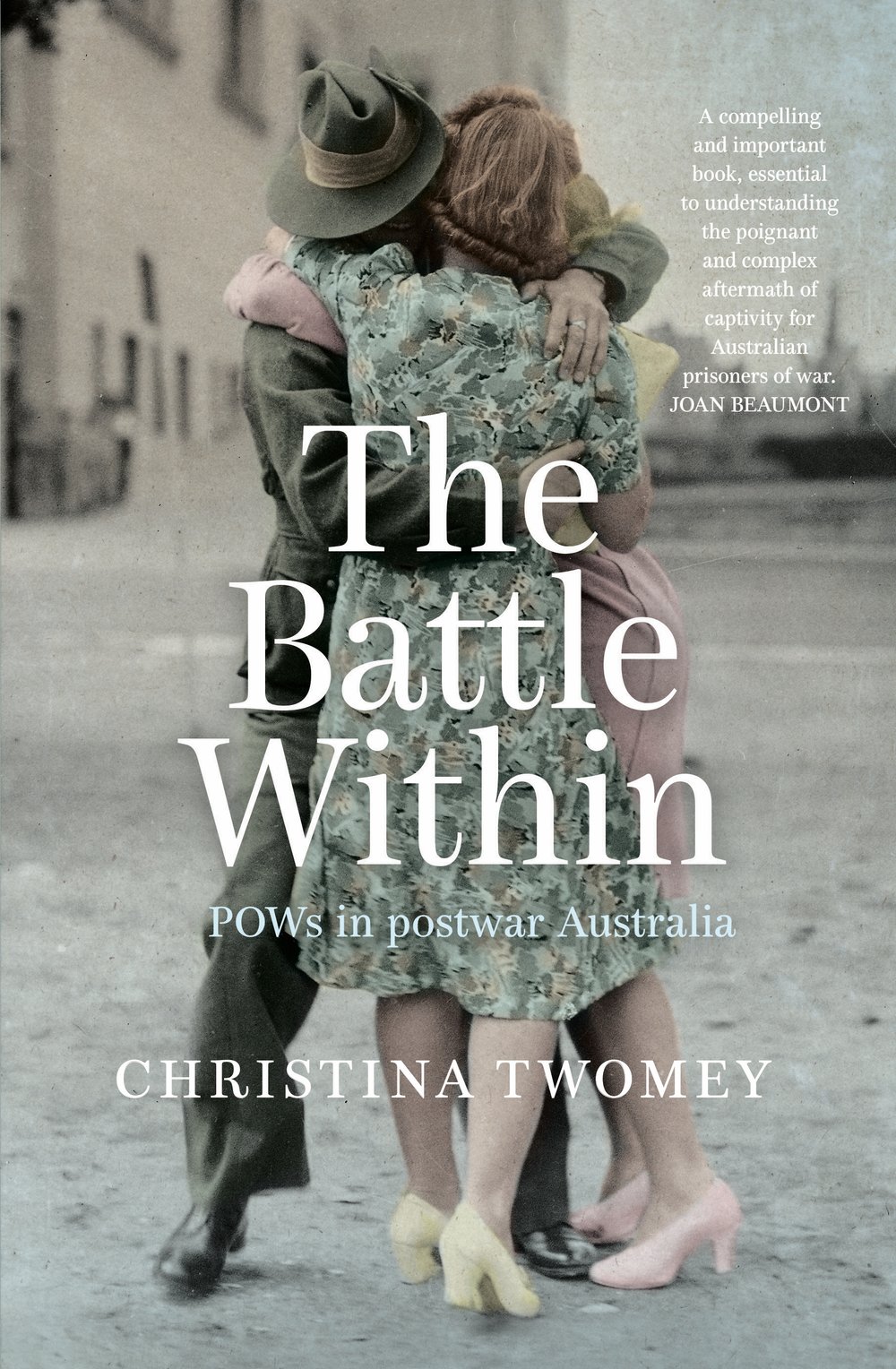Edited extract from the Prologue to The Battle Within by Christina Twomey
Before dawn on 25 April 2012 I walked along the remains of the Thai–Burma Railway. Its iron tracks had been ripped up long ago. The original wooden sleepers, their surface at once cracked and polished by monsoonal rains, were partly obscured by small grey stones. The railway cutting is deep and narrow, with rock face looming on each side. Asian romusha (forced labourers) and Allied prisoners of war (POWs) chiselled out this railway pass in the early 1940s to facilitate Japan’s Thai–Burma Railway project. Seventy years later the beauty of this man-made valley, with its floor of pale stones and crown of green foliage, flames from bamboo lanterns illuminating its orange walls, belied the human cost of its creation. On the morning of my visit, no one spoke as they picked their way along the pathway of sleepers towards the black stone memorial. The crunch of gravel beneath our feet was reminiscent of a purposeful march.
The remote location of Hellfire Pass, in the western Thai province of Kanchanaburi, near the border with Burma, is several hours’ journey by bus from Bangkok. Yet at least 1000 other people were there that morning, many of them Australians. All of those present had descended the wide wooden steps to the railway cutting from the Hellfire Pass Memorial Museum, an institution built and funded by Australia’s federal government. They gathered at this dawn service to hear the Anzac Day address and to pay their respects to the people who had suffered and died on the railway.
-----
This book is the result of that journey along the remains of the railway, which led me back into the archive to explore how the Australian government and people have responded to POWs. Recalling the richness of the Civilian Internees’ Trust Fund, I wondered if something similar had been created for military POWs. Indeed it had: the Prisoners of War Trust Fund received over 7000 applications for grants. The vast majority of the documents had not been consulted since the day they were filed away. All former POWs who received a service pension have a repatriation file, currently in the possession of the Department of Veterans’ Affairs. That archive remains closed to the public. The Prisoners of War Trust Fund is therefore the best archival source currently available for a study of former POWs.
A discretionary fund, controlled by government-appointed trustees (several of whom were themselves former prisoners), the Prisoners of War Trust Fund was in operation for a quarter of a century, from 1952 to 1977. Applications to the fund now provide astonishing insight into the lives, experiences and perceptions of people not usually given to recording or in any event keeping such records of their feelings about the impact of imprisonment. The applicants to the fund were, by and large, from the ‘other ranks’: men of limited education who often had menial jobs and sometimes lives blighted by alcoholism, depression, marriage breakdown or loneliness. Yet many of them took the opportunity, in shaky handwriting or in bold, capital letters, to make known their views about the treatment meted out to former prisoners, their family troubles and their struggles to rehabilitate.
The fund gave rise to an archive of extraordinary richness and while the letters and forms it contains were composed in the hope of receiving some kind of monetary payment, the themes that recur in the correspondents’ pleas suggest common experience rather than collusion. The decisions and actions of the trustees, men distributing public money who applied their own private standards of appropriate behaviour and respectability, reflect the chasm that could exist between social classes in postwar Australia. The documents also flag the disparity of views that existed among former prisoners about mental illness and the significance of imprisonment itself. The applicants to the fund sometimes commented on the government’s attitude towards them. More often, they wrote about their personal experiences.
Reading about the struggles of so many former POWs to rehabilitate themselves, to find work and to reintegrate into their family and community, and the remarkable frankness with which these men discussed their problems with sex and with alcohol, made me realise that I could not write a book about the place of former prisoners in postwar Australia without taking account of the personal cost of captivity. Rather than interviewing former POWs about their memories of those postwar years, I have concentrated on how returned POWs wrote and thought about such issues at the time they occurred. One applicant’s file provided the title for the book, when he pleaded for people to recognise that former POWs were required to overcome a ‘battle within’ themselves to put the past behind them.
The ‘battle within’ was national as well as personal: the Australian government had to be persuaded that a defeated soldier was worthy of commemoration and respect. Until the 1980s the Australian Army and the Australian government had a deeply equivocal attitude to former POWs. Just as the papers of the Prisoners of War Trust Fund reward us with their insight into the views of ‘ordinary’ former prisoners, so the bureaucratic records of the army and the Repatriation Department, which oversaw veterans’ access to welfare based on their service, reveal the arguments they were disinclined to make in public. Here, the ambivalence towards former prisoners ran deep.
-----
Just as a visitor to Hellfire Pass can pick out the railway line by glimpsing the sleepers beneath the gravel, as a historian I have dug deep in the archive to reveal the foundations of the POW story in Australian culture. It is tempting to see the current veneration of former POWs as running along clean iron rails, from the past to the present. This book suggests that the sidings were many, that the tracks were buckled and warped, and that the burden of this difficult journey fell most heavily on the people with the least social, cultural and economic resources to carry it.

